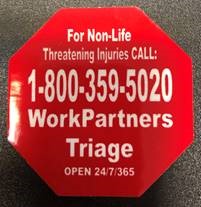What is crystalline silica (quartz)?
The term “crystalline silica” and “quartz” refer to the same thing. Crystalline silica is a natural constituent of the earth’s crust and is a basic component of sand and granite.
What is silicosis?
Silicosis is a disease of the lungs due to the breathing of dust containing crystalline silica particles. This dust can cause fibrosis or scar tissue formations in the lungs that reduce the lung’s ability to work to extract oxygen from the air. There is no cure for this disease, thus, prevention is the only answer.
What are the symptoms of silicosis?
There are several stages of silicosis. Early stages may go completely unnoticed. Continued exposure may result in the exposed person noticing a shortness of breath upon exercising, possible fever and occasionally bluish skin at the ear lobes or lips. Silicosis makes a person more susceptible to infectious diseases of the lungs like tuberculosis. Progression of the disease leads to fatigue, extreme shortness of breath, loss of appetite, pain in the chest, and respiratory failure, which all may lead eventually to death. Acute silicosis may develop after short periods of exposure. Chronic silicosis usually occurs after 10 or more years of exposure to lower levels of quartz.
Where are construction workers exposed to crystalline silica dust?
The most severe exposures to crystalline silica result from sandblasting to remove paint and rust from stone buildings, metal bridges, tanks, and other surfaces. Other activities that may produce crystalline silica dust include jack hammering, rock/well drilling, concrete mixing, concrete drilling, and brick and concrete block cutting and sawing. Tunneling operations; repair or replacement of linings of rotary kilns and cupola furnaces; and setting, laying and repair of railroad track are potential sources of crystalline silica exposure.
How is OSHA addressing exposure to crystalline silica-containing dust?
OSHA has established a Permissible Exposure Limit, or PEL, which is the maximum amount of airborne crystalline silica that an employee maybe exposed to during the work-shift. OSHA is also beginning a Special Emphasis Program to inform employers and employees about the occurrence and hazards of crystalline silica and ways to reduce exposure to the dust.
What can employees do to limit their exposure to crystalline silica?
- Be sure to use all available engineering controls such as water sprays and ventilation of containment structures. Substitution of less hazardous materials can also be used.
- Be aware of the health effects of crystalline silica and that smoking adds to the damage.
- Know the work operations where exposure to crystalline silica may occur.
- Participate in any air monitoring or training programs offered by the employer. For other operations where respirators maybe required, wear a respirator approved for protection against crystalline silica-containing dust.
- If using a Respirator, do not alter the respirator in any way. Workers who use tight-fitting respirators cannot have beards/mustaches which interfere with the respirator seal to the face.
- Do not eat, drink, use tobacco products, or apply cosmetics in areas where there is dust containing crystalline silica. Wash hands and face before eating, drinking, smoking, or applying cosmetics outside of the exposure area.
- If you have questions about silica on your specific jobsite. Please contact your safety manager.

